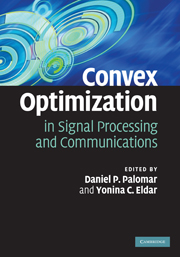Book contents
- Frontmatter
- Contents
- List of contributors
- Preface
- 1 Automatic code generation for real-time convex optimization
- 2 Gradient-based algorithms with applications to signal-recovery problems
- 3 Graphical models of autoregressive processes
- 4 SDP relaxation of homogeneous quadratic optimization: approximation bounds and applications
- 5 Probabilistic analysis of semidefinite relaxation detectors for multiple-input, multiple-output systems
- 6 Semidefinite programming, matrix decomposition, and radar code design
- 7 Convex analysis for non-negative blind source separation with application in imaging
- 8 Optimization techniques in modern sampling theory
- 9 Robust broadband adaptive beamforming using convex optimization
- 10 Cooperative distributed multi-agent optimization
- 11 Competitive optimization of cognitive radio MIMO systems via game theory
- 12 Nash equilibria: the variational approach
- Afterword
- Index
Preface
Published online by Cambridge University Press: 23 February 2011
- Frontmatter
- Contents
- List of contributors
- Preface
- 1 Automatic code generation for real-time convex optimization
- 2 Gradient-based algorithms with applications to signal-recovery problems
- 3 Graphical models of autoregressive processes
- 4 SDP relaxation of homogeneous quadratic optimization: approximation bounds and applications
- 5 Probabilistic analysis of semidefinite relaxation detectors for multiple-input, multiple-output systems
- 6 Semidefinite programming, matrix decomposition, and radar code design
- 7 Convex analysis for non-negative blind source separation with application in imaging
- 8 Optimization techniques in modern sampling theory
- 9 Robust broadband adaptive beamforming using convex optimization
- 10 Cooperative distributed multi-agent optimization
- 11 Competitive optimization of cognitive radio MIMO systems via game theory
- 12 Nash equilibria: the variational approach
- Afterword
- Index
Summary
The past two decades have witnessed the onset of a surge of research in optimization. This includes theoretical aspects, as well as algorithmic developments such as generalizations of interior-point methods to a rich class of convex-optimization problems. The development of general-purpose software tools together with insight generated by the underlying theory have substantially enlarged the set of engineering-design problems that can be reliably solved in an efficient manner. The engineering community has greatly benefited from these recent advances to the point where convex optimization has now emerged as a major signal-processing technique. On the other hand, innovative applications of convex optimization in signal processing combined with the need for robust and efficient methods that can operate in real time have motivated the optimization community to develop additional needed results and methods. The combined efforts in both the optimization and signal-processing communities have led to technical breakthroughs in a wide variety of topics due to the use of convex optimization. This includes solutions to numerous problems previously considered intractable; recognizing and solving convexoptimization problems that arise in applications of interest; utilizing the theory of convex optimization to characterize and gain insight into the optimal-solution structure and to derive performance bounds; formulating convex relaxations of difficult problems; and developing general purpose or application-driven specific algorithms, including those that enable large-scale optimization by exploiting the problem structure.
- Type
- Chapter
- Information
- Convex Optimization in Signal Processing and Communications , pp. xi - xivPublisher: Cambridge University PressPrint publication year: 2009
- 2
- Cited by

